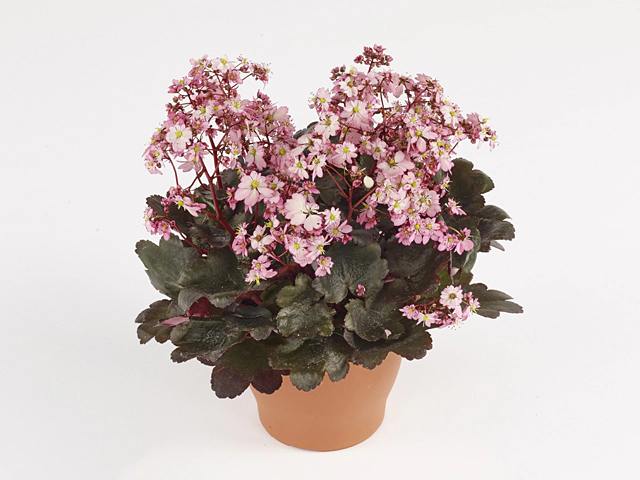Saxifraga cortusifolia Dancing Pixies Tilda

| Flower type | Single |
| Flower scent | Unscented |
| Winter hardness | Reasonable (USDA-zone 7) |
| Flower color | Pink-medium blue pink-062B |
| Flower diameter | 2,5 - 3 cm |
| Plant height | 10 - 20 cm; 20 - 30 cm |
| Inflorescence | Raceme |
| Flowering month(s) | August; September; October; November |
| Leaf surface | Bullate; Hairy |
| Leaf size | 5 - 7,5 cm |
| soil pH requirement | Alkaline (pH > 7,5); Neutral (pH 6,5 - 7,5) |
| Leaf division | Digitate-lobed; Simple |
| Plant, growth type | Erect |
| Leaf, main color | Dark green |
| Flower color distribution | Bicolored; With trace |
| Flower, secondary color(s) | White-white-NN155B |
| Moisture requirements | Moist; Well-drained |
Saxifraga cortusifolia Dancing Pixies Tilda, also known as Saxifrage, is a beautiful flowering plant that belongs to the Saxifraga genus. This plant is known for its single-flower type and unscented flowers. It is reasonably resistant to winter conditions and can thrive in USDA Hardiness Zone 7.
The flowers of Saxifraga cortusifolia Dancing Pixies Tilda are a stunning pink-medium blue, categorized as pink-062B. They have a diameter of 2.5 to 3 centimeters, making them small and delicate. The plant itself can grow to a height of 10-20 centimeters or 20-30 centimeters, depending on the variety.
The plant produces its flowers in racemes, creating a beautiful display of blooms. The flowering period begins in August and continues until November, making it a great option for adding color to your garden during the late summer and fall months.
The leaves of this Saxifraga variety are unique, with a bullate (blistered) and hairy surface. They can grow up to 5-7.5 centimeters in size. The plant's pH requirements are either alkaline (pH > 7.5) or neutral (pH 6.5 - 7.5). This makes it adaptable to a wide range of soil types.
The leaves are divided into either digitate-lobed or simple structures, enhancing the plant's visual appeal. The main color of the leaves is a dark green shade, adding a lush and vibrant touch to the overall aesthetics.
The flower color distribution of Saxifraga cortusifolia Dancing Pixies Tilda is bicolored, with a trace of a secondary color. The secondary color is white, specifically labeled as white-NN155B. This combination of colors creates a visually appealing contrast that further enhances the beauty of the plant.
To grow Saxifraga cortusifolia Dancing Pixies Tilda successfully, it is essential to provide it with appropriate moisture levels. The plant prefers moist soil that is well-drained. Regular watering and ensuring the soil doesn't become waterlogged will help promote healthy growth and blooming.
In conclusion, Saxifraga cortusifolia Dancing Pixies Tilda is a delightful flowering plant that offers a beautiful display of pink to medium blue flowers. With its unique leaf structure, adaptability to various soil pH levels, and preference for moist, well-drained soil, this plant is a charming addition to any garden. It blooms from August to November, adding a splash of color during the late summer and fall months. Whether planted in flower beds or pots, Saxifraga cortusifolia Dancing Pixies Tilda is sure to captivate all who see it with its exquisite beauty.
Market availability index by month:
| Jan. | Feb. | Mar. | Apr. | May | Jun. | Jul. | Aug. | Sep. | Oct. | Nov. | Dec. |
|---|---|---|---|---|---|---|---|---|---|---|---|
| 2 | 3 | 4 | 3 | 1 | 1 | 1 | 1 | 1 | 1 | 1 | 1 |